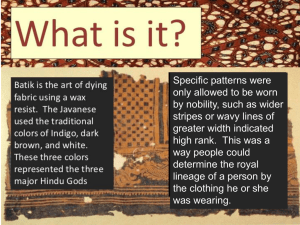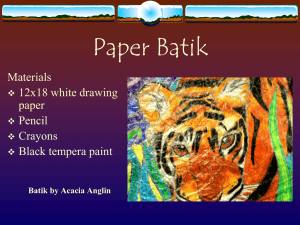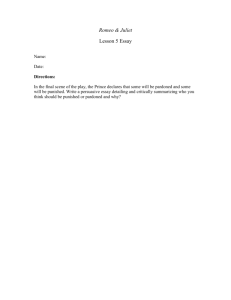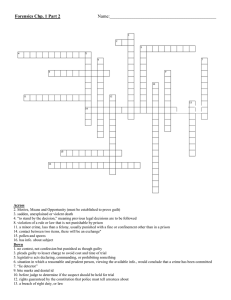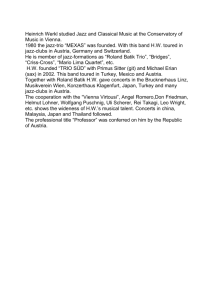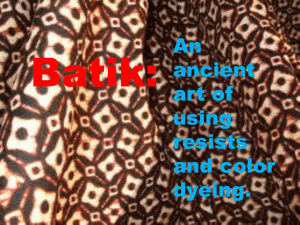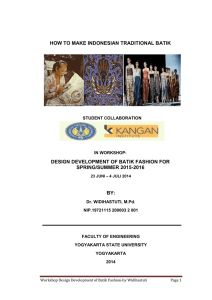A. Reading NATURAL AND ARTIFICIAL PROCESS
advertisement
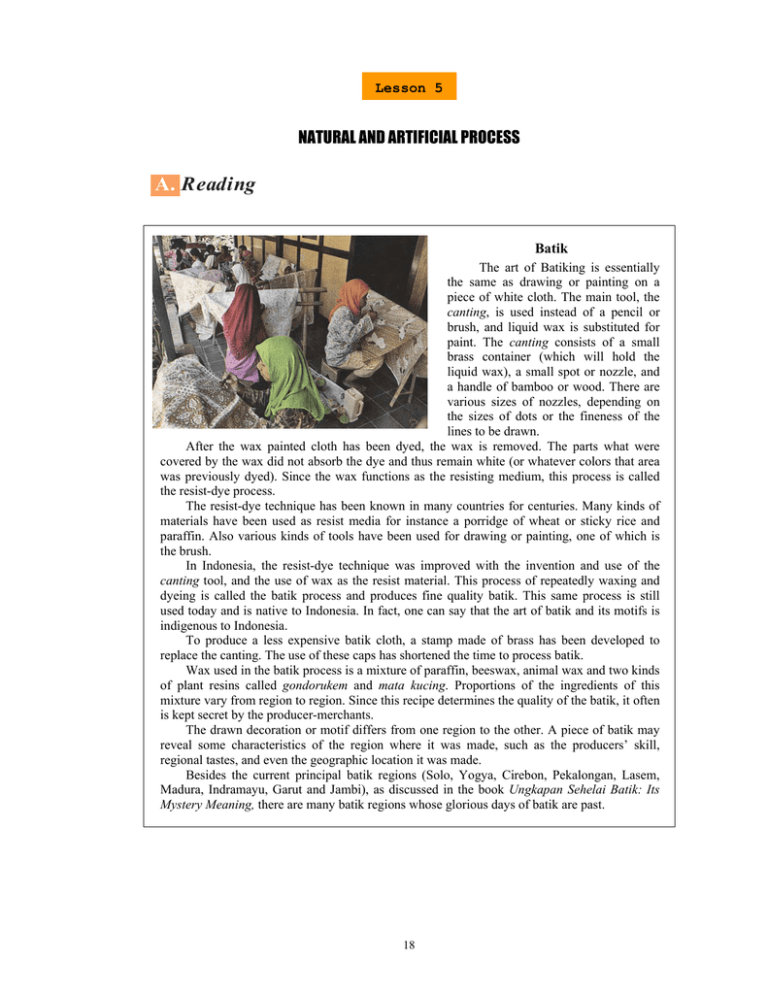
Lesson 5 NATURAL AND ARTIFICIAL PROCESS A. Reading Batik The art of Batiking is essentially the same as drawing or painting on a piece of white cloth. The main tool, the canting, is used instead of a pencil or brush, and liquid wax is substituted for paint. The canting consists of a small brass container (which will hold the liquid wax), a small spot or nozzle, and a handle of bamboo or wood. There are various sizes of nozzles, depending on the sizes of dots or the fineness of the lines to be drawn. After the wax painted cloth has been dyed, the wax is removed. The parts what were covered by the wax did not absorb the dye and thus remain white (or whatever colors that area was previously dyed). Since the wax functions as the resisting medium, this process is called the resist-dye process. The resist-dye technique has been known in many countries for centuries. Many kinds of materials have been used as resist media for instance a porridge of wheat or sticky rice and paraffin. Also various kinds of tools have been used for drawing or painting, one of which is the brush. In Indonesia, the resist-dye technique was improved with the invention and use of the canting tool, and the use of wax as the resist material. This process of repeatedly waxing and dyeing is called the batik process and produces fine quality batik. This same process is still used today and is native to Indonesia. In fact, one can say that the art of batik and its motifs is indigenous to Indonesia. To produce a less expensive batik cloth, a stamp made of brass has been developed to replace the canting. The use of these caps has shortened the time to process batik. Wax used in the batik process is a mixture of paraffin, beeswax, animal wax and two kinds of plant resins called gondorukem and mata kucing. Proportions of the ingredients of this mixture vary from region to region. Since this recipe determines the quality of the batik, it often is kept secret by the producer-merchants. The drawn decoration or motif differs from one region to the other. A piece of batik may reveal some characteristics of the region where it was made, such as the producers’ skill, regional tastes, and even the geographic location it was made. Besides the current principal batik regions (Solo, Yogya, Cirebon, Pekalongan, Lasem, Madura, Indramayu, Garut and Jambi), as discussed in the book Ungkapan Sehelai Batik: Its Mystery Meaning, there are many batik regions whose glorious days of batik are past. 18 19 Natural and Artificial Process Exercise Read each statement bellow. If the statement is correct according to the article, put a tick (√). If the statement is wrong, put a cross (x), and correct the statement. 1. The canting is the main tool and substituted for paint in batik. 2. The part what are covered by the wax is still white because it didn’t absorb the dye although cloth has been dyed. 3. The resist-dye technique is batik process that used the wax functions as the resisting medium. 4. In the resist-dye technique in batik, only wax can be as resist media. 5. Batik is the process of repeatedly waxing and dyeing. 6. The resist-dye technique is a characteristic of Indonesia. 7. Producing batik with a tool that consist of a small brass container, a small spot or nozzle, and a handle is less expensive than a stamp made of brass. 8. A stamp made of brass is suitable for mass production of batik. 9. Wax is a mixture of paraffin, beeswax, animal wax and two kinds of plant resin, called gondorukem and mata kucing. 10. As a indigenous to Indonesia, the drawn decoration of batik is same from one region to the other in Indonesia. B. Vocabulary Cohesive Devices Cohesive devices are words used by a writer to link the sentences of a paragraph. To be cohesive means to be attached tightly with each other. This link is done by using cohesive devices. In addition to making a link, cohesive devices may also often function to provide variation in the way a paragraph is written. Look at the paragraph below. The type of food eaten by a fish changes as it grows. A newly-hatched trout does not feed at all during the first weeks of life. In contrast, a newly-hatched perch is active as soon as it hatches. It swims up to the surface of the water and take in air to inflate its swim bladder. Air must be swallowed into the swim bladder through the gut before the perch is a few days old. A group of trout like to swim around white rocks. Meanwhile, perches like to form another group. They like to hang around the wild weeds. The use of in contrast in line 2 links Sentence 2 to Sentence 1. By reading this cohesive device, we can understand that the writer is comparing between trout and perches. The use of meanwhile, also links between this sentence and the sentence before. Below are some other cohesive devices. These are not the complete examples. You have to look into your dictionary to find more of such words used as cohesive devices. 20 Natural and Artificial Process Words Function Example Personal pronouns: he, him, she, it, them, you, one, ones, etc. substitution Demonstratives: this, that, these, such those, two, three, etc. substitution Comparatives: the former, the latter the first, the last substitution There are two basic techniques of reading: skimming and scanning. The former is used for fast reading. The latter is used for reading for detailed information. who, whom, which, etc. do, will, has, etc. so substitution It is the persons with the least food, clothing, and housing whom you have to help in this program. to begin with, then, moreover, finally, etc. listing To begin with, you should look at the tank. If you don’t find anything wrong, then you ... besides, in any case, anyway, what’s more, furthermore, etc. reinforcement I won’t be coming. I have some work to do. Besides, I don’t think this is the right to time to play the game. in a word, in short, to sum up, altogether, in all, to conclude summarizing Each chapter is supported by a reference; in short, this is a carefully-written material. that is, that is to say, namely, i.e., viz., etc. explanation At least one person, namely the President himself, supports the proposal. but, though, despite, however, nevertheless, etc. contrast Although he was very tired, he worked hard until after midnight. for, since, because, considering, due to, in view of, etc. cause/reason Due to the bad weather, we had to postpone the performance. so, so that, therefore, as a result, etc. effect/result He ran out of money. Therefore, he had look for a job. substitution Three young boys were arrested for ripping off public phones. These youths were not aware of the consequences of their act. When she was chosen as the first woman in space, Sally Ride joined the training program together with five other women and thirty-four men. The Aleuts and the Eskimo speak similar languages. This indicates that the two once shared a common tongue. Conjunctives: Synonyms 21 Natural and Artificial Process Exercise Fill in each blank with a conjunction from the list. You need to be extra careful because some of conjunctions may slightly overlap. 1. Left-handed people suffer more from their right-handed peers; -----, they smoke and drink more. a. therefore 2. Reports state that yogurt eaters have better and healthier lives than non-yogurt eaters; ----- there is no proof that this is supported by facts. c. as a result b. such as d. above all e. afterward 3. You must listen to their complaints, control your reactions, and give your best comments. -----, you must be responsive to their emotional explosions. 4. The oil embargo caused difficult problems for many automobile factories in the world; -----, companies in Germany should produce smaller cars. 5. The documents should include your student card, a copy of your grade-point report, and a consent from your academic advisor. -----, these documents should be photocopied twice. 6. Each day trip will include a specific theme in nature; ----- the weather, birds, fishes, and plant ecology. 7. The idea that “a woman’s place is at the home” no longer applied to the brave ladies in space; -----, it was no surprise when Svetlana Savitskaya orbited the earth and landed safely after being in space for three days. 8. Instead of making revision on his work, he did not do anything last night. ----, he did not want to make any improvement at all. 9. Studies indicate that people who eat salt suffer the most from hypertension; -----, tribesmen and women who do not eat salt are free from hypertension. 10. The prisoners ate their morning meal at about six o’clock. -----, they picked up their tools and worked on their handicrafts. f. on the other hand g. in fact h. however i. furthermore j. in particular 22 Natural and Artificial Process C. Grammar Passives: Simple Tenses Most of us are already familiar with the passive voice. It is the sentence which takes to be + past participle as its verb. There can be two ways to understand the passive voice. We will call these: simple passive voice and complex passive voice. Today, we will study the former. ACTIVE The headmaster often punishes him. The headmaster punished him yesterday. PASSIVE He is often punished by the headmaster. He was punished by the headmaster yesterday. They were punished by the headmaster. The headmaster punished them yesterday. As you can see from the examples above, the verb of the passive voice is constructed of to be + past participle. They are is punished, was punished, and were punished. The more complete forms of the be verbs are as follows: Singular Present Plural 3rd person He She It is punished. They are punished. 1st person I am punished. We are punished. 2nd person are punished. You are punished. They were 1st person You He She It I was We were punished. 2nd person You were You were punished. Past 3rd person was punished. punished. punished. punished. Because we use the be verb, we must always think of the agreement between the verb and the subject and the tense. As we can see in the above table, we can ask these questions: ♦ Is the active sentence in the present or past tense? ♦ Is the subject of the passive sentence the first, second, or third person? ♦ Is this subject singular or plural? The steps for changing the active sentence into the passive voice is as follows: 1) Pick out the object of the active sentence to be used as the subject of the passive sentence. 2) Select the form of the verb be according to the considerations above. 3) Turn the full verb of the active sentence into the past participle form. 4) Complete the sentence. 23 Natural and Artificial Process Exercise Rewrite the sentences in their passive forms. The first sentence is given as an example. It is useful to follow the procedure given above step by step. 1. The Swiss nation does not need submarines. Submarines are not needed by the Swiss nation. 2. The vertical line divides the space. 3. The teacher gives us many assignments each week. 4. PT Dino Industrial Ltd. produces various Biore make-ups. 5. The central authority plans the whole information program. 6. The government issued the regulations yesterday. 7. In 1992, the government set up an official planning body. 8. The committee punishes you for bad conducts. 9. The students discussed the solution to the problems yesterday. 10. Hair covers the whole body of the animal. 11. The scientists recognize seven sub-species of animals. 12. They told me about the accident yesterday. 13. The utility determines the relationship between a consumer and a commodity. 14. The cash account shows the cash effects of business transaction. 15. He combines them into seven species.
